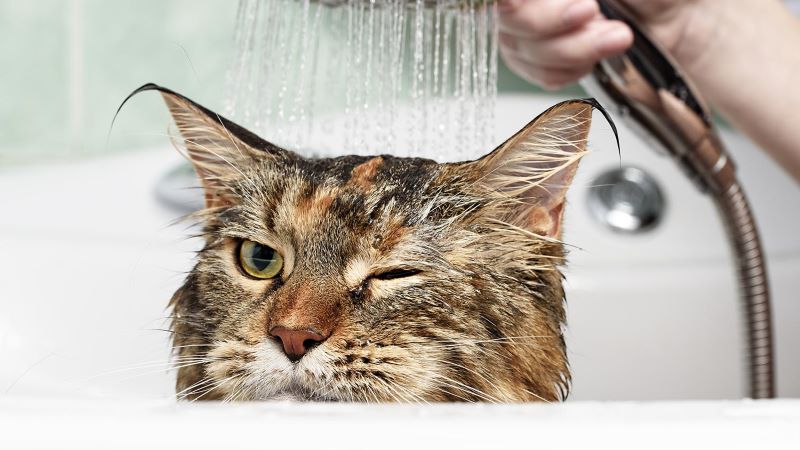Cats are pretty independent creatures. They take care of their grooming, for the most part, using their barbed tongue. According to Dr. Cynthia McManus of Just Cats Veterinary Services, a healthy cat grooms himself up to 50 percent of the waking day. But sometimes, cats need a bit of assistance. There are many reasons a cat may stop grooming himself. If your cat has soiled himself in the litter box or gotten into a mess that he can’t seem to get himself out of – climbed up the chimney or tousled with a skunk – you may need to take it upon yourself to help with his grooming. Some cats develop acne and need their face washed frequently. So we’re here to walk you through the washing process, so you can complete the task of bathing your cat and live to tell about it.
Introduce Bathtime Early
It is important to help your cat become accustomed to bathing from a young age. Kittens who are bathed grow up to be cats who tolerate baths better. But be careful when you bathe your kitten. Kittens do not have the fat reserves to stay warm when they are wet, so make the bath a quick one, and be sure to towel him off right away afterward.
Before You Begin
Let’s start with what you should have at the ready. The more prepared you are, the better.
-
Kitchen sink or a large tub
-
Towel for the bottom of the tub
-
Cat shampoo (or mild baby shampoo) and a small bowl
-
Pitcher or cup
-
Large towel (bonus points if it just came out of the dryer)
-
Cotton balls for ears
-
Small washcloth for face
How to Bathe Your Cat
Once you have all your materials in place, it is time to get to work!
-
Let your cat watch while you fill the kitchen sink or a large tub. Place a towel in the bottom of the sink or tub so your cat has something to sink his claws into that is not your arm!
-
Place your cat in the tub, and gently hold him in place. Wet his paws first, then work toward his legs and trunk, moving slowly. Keep his face dry.
-
Mix the cat shampoo with water in a small bowl and massage the diluted solution into his coat.
-
Use the cup to thoroughly rinse the soap away.
-
Do not use soap on his face. Simply use a washcloth to wipe with water.
-
Place your cat on a warm towel and carefully wrap him up.
-
Use cotton balls to gently wipe his ears. Never try to clean debris from the inside of the ear canal--let your vet do that.
Brushing Your Cat
If you’re feeling ambitious, after your cat is completely dry, you can use a de-shedding tool to brush him. Frequent brushing can reduce hairballs. If your cat has short hair, he’ll need to be brushed once a week. Long-haired cats need to be brushed every other day. Gently stroke your cat before drawing the brush across the top of his coat, trying not to catch his hair in the teeth of the comb.
Bathe Only When Necessary
Cats do not need to be bathed often, as they are pretty self-sufficient. Their tongue is adept at removing dead or loose fur, cleaning food from their whiskers and body, and ridding their coat of fleas and parasites. But if you do need to bathe your cat, following our tips should make the process less painful. Our biggest piece of advice is to stay calm. As Dr. Liz Bales, a veterinarian and founder of the Feline Environmental Enrichment Design Company says “The more gradual and relaxed the experience, the more relaxed you are. Cats are perceptive to our feelings. If we’re in a high state of anxiety, they will sense that.”
Let Pet Insurance Help
Some cats may stop bathing themselves because of a health condition, which means not only do you have to face the task of bathing your cat, but also the vet bills that come with treatment! Pet insurance can provide coverage for illnesses, accidents and wellness care to help keep your cat healthy. Get a quote today!

